Gravel Race Prep Series: Rider Kit / Clothing Choice
- Written by Keith Huster
- /
- 12 min read
- /
- Last updated 9 months ago
Wearing proper cycling clothing can make you look and feel professional. It can also dramatically increase your aerodynamics and overall comfort. In this post, I will cover my thoughts and recommendations on how to properly dress for a gravel race so that you can avoid those common rookie mistakes.
⦿ Part 1: Physical Endurance
⦿ Part 2: Mental Fortitude
⦿ Part 3: Bike Setup and Tire Choice
⦿ Part 4: Nutrition and Hydration
⦿ Part 5: Rider Kit / Clothing Choice (this post)
⦿ Part 6: Final Preparations
Wear a cycling jersey
There are many benefits to wearing a cycling-specific jersey during a gravel race. However, if you are anything like me, you probably don't always wear a cycling jersey when you ride. Cycling-specific jerseys can be very expensive! If you shop around though, you can often find deals at local bike shops or online retailers. Also, cycling jerseys may not be considered fashionable for your preferred riding discipline (e.g. mountain biking, casual riding, etc.). I personally feel more natural wearing a loose-fitting athletic shirt while I am out riding. Even so, it's hard to look past all of the benefits of a good cycling-specific jersey.

GORE WEAR Men's Short Sleeve Cycling Jersey
- Lightweight men's jersey for cyclists in warm weather conditions
- Form-Fit/Bike specific cut
- GORE Selected Fabrics: Fast moisture-wicking and extremely breathable
Cycling jersey benefits
- Aerodynamic advantage: A snug-fitting jersey provides an aerodynamic advantage over loose-fitting clothing. This will pay off when you are out there riding for multiple hours across a long gravel race course.
- Temperature compensation: Most jerseys offer a front zipper that allows you to control the airflow to your core. Zip it down when the temperature rises to allow more airflow to cool your core. Zip it up when the temperature drops to provide better insulation for your core.
- Moisture management: Cycling jersey material is designed specifically to wick away moisture from your body. These materials work far better than the traditional fitness clothing that you may be accustomed to wearing.
- Easy-access pockets: Cycling jerseys typically offer up to three rear-facing pockets. These pockets are designed to carry essentials you might need immediate access to such as a multitool, energy gels, a stashable rain jacket, etc.
Prior to the Salty Lizard 100 gravel race, I was fortunate enough to find a like-new cycling jersey at a local thrift store. I picked up the jersey for only $5 USD. That's a huge saving over the typical $50-$100 USD price tag for a name-brand jersey. I wore the jersey on several training rides in order to become accustomed to it before the race. It took a few hours of wearing the jersey to get comfortable adjusting the zipper and accessing the rear-facing pockets while riding on rough trails. So, I would highly recommend that you spend some time familiarizing yourself with the jersey that you plan to wear during a race.
Embrace Lycra cycling shorts
Yep, I never thought that I would be that guy out there riding my mountain bike wearing tight-fitting Lycra cycling shorts. But, here I was, at the starting line looking like a full-on road cyclist! So, why did I choose to wear Lycra shorts? Well, I'll cover those reasons in a few moments but first I need to talk about the issues that I have encountered while wearing baggy shorts on long training rides.
I personally don't feel all that comfortable being out in public wearing shorts that leave little to the imagination. 😳 However, I also am all too familiar with the issues that can result from wearing baggy shorts while riding for multiple hours at a time.
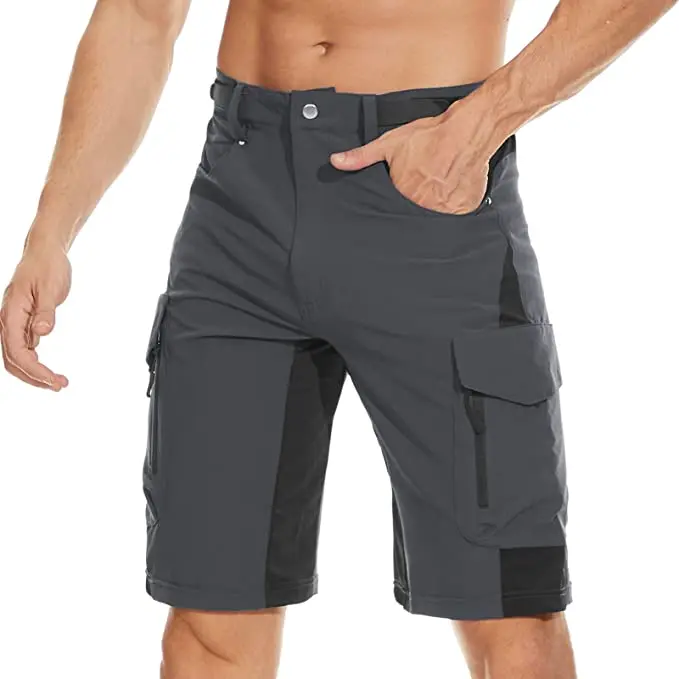
Cycorld Mens Mountain Bike Shorts
These are my daily driver baggy shorts. They are inexpensive and very durable. I wear these while riding with friends and during training rides.
- Sweat wicking, quick dry and elastic fabric with reflective strips to keep you move and shine through every move
- Plenty of pockets and zipper combined to help you store and move.
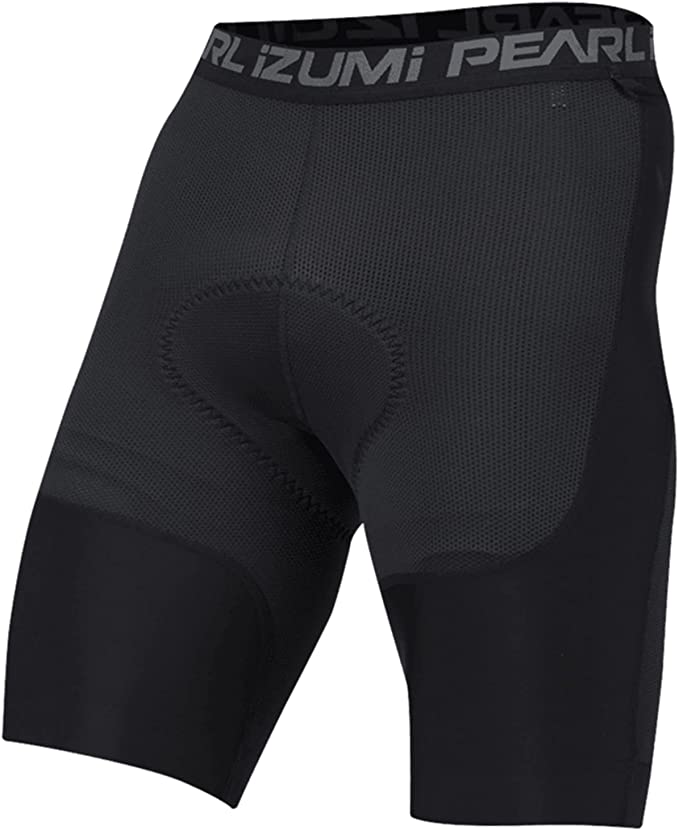
PEARL IZUMI Men's Select Liner Cycling Shorts
I wear these liner shorts underneath my baggy shorts. These are very comfortable and provide plenty of padding between you and your bike saddle. Note that these are somewhat see-thru so you shouldn't wear these as an outer layer.
- SELECT Escape 1: 1 Chamois provides optimal moisture transfer and odor resistance
- Updated pattern contours to the body for an optimal fit when riding
- Transfer mesh fabric on the main body to prevent overheating while wearing shell shorts
- Transfer fabric on lower legs is designed to allow shell shorts to move without friction during pedaling
- A wide waistband provides comfort without extra pressure
Issues with baggy shorts
- Aerodynamic disadvantage: Baggy-fitting shorts may look stylish and feel comfortable but that comes at the cost of increased aerodynamic drag while riding. That increased drag results in wasted watts throughout the course of the race.
- Inadequate moisture control: I have found that the materials used to design baggy cycling shorts often do not wick moisture away as well as those used in tight-fitting cycling shorts. This can lead to the shorts feeling "heavy" over time due to moisture buildup.
- Hot spots/chafing: Baggy cycling shorts allow for the movement of the material across your bare skin. This style of shorts can also sometimes cause bunching between your skin and the bike saddle. Over time, these issues can cause chafing, hot spots, and general discomfort while riding.
- Separate padded liner: There is a separation between the inner padded liner shorts and the outer baggy shorts. This can sometimes result in uncomfortable movement between the two sets of materials such as when the outer materials tug on the inner liner causing it to ride up.
Those are some of the key reasons that I recommend avoiding wearing baggy shorts during a gravel race. Ok, now let's talk about the advantages of wearing Lycra cycling shorts.
Tight-fitting Lycra shorts benefits
- Aerodynamic advantage: Tight-fitting shorts minimize aerodynamic drag while riding. This helps to conserve precious watts throughout the course of the race.
- Excellent moisture management: Tight-fitting Lycra shorts have excellent moisture-wicking capabilities. This is in part due to the material composition and its proximity to your skin. The ability to properly control moisture results in a significant increase in comfort throughout a race.
- Little to no chafing: Lycra shorts are designed to become one with your body. They move as if they are a direct extension of your skin. This design helps to ensure that the shorts do not rub on your skin thus preventing hot spots and chafing.
- Muscle compression: Cycling shorts can offer varying levels of compression on your leg and glute muscles. This has the advantage of helping to control muscle fatigue while you are riding.
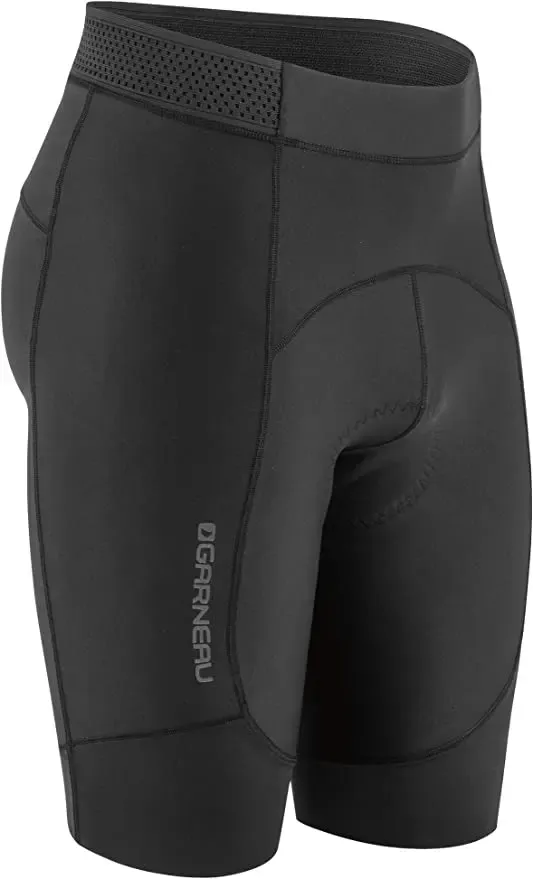
Louis Garneau, Men's Neo Power Motion Bike Shorts
I wore these cycling shorts during the Salty Lizard 100 gravel race. I was very impressed with the moisture-wicking capabilities and overall comfort.
- The Motion Airgel chamois is made from high-density foam and a perforated gel insert that offer comfort and breathability while eliminating pinching and chafing.
- Compressive: The Neo Power Motion shorts' compression favors blood circulation to the muscles, which allows for better performance and increased resistance to fatigue.
- Stay in place: The Powerband compressive cuff reduces lower leg pressure, provides support, and keeps the garment in place without restricting circulation.
- Comfortable: The flatlock seams offer greater comfort. The Power + Lycra compression fabric fits the muscle shape and provides maximum support.
- Visible: The reflective accents provide extra safety in low light.
Lycra cycling shorts can be a polarizing outfit choice. Hopefully, I have helped you to see past those concerns and embrace the benefits of this marvelous material. I would love to hear your thoughts on this topic in the comments section at the bottom of this post.
Wear walkable shoes and socks
The need to walk comfortably was not something that I had considered when I first started researching gravel races. I had assumed that gravel race courses would generally be mellow and fully rideable. Boy was I wrong! Gravel race courses will often contain one or more sections that require riders to dismount and walk their bike. These sections may be planned (e.g. steep, rocky hike-a-bike sections) or completely unexpected (e.g. deep mud due to unexpected heavy rainfall) by the course designers. Either way, you should be prepared for such sections during a race.
If you choose to run flat pedals then you are more than likely good to go. Most flat pedal shoes are inherently designed to be comfortable for walking. During the Salty Lizard 100 race, I ran a set of One Up Components composite pedals paired with a set of Five Ten Freerider Pro mountain biking shoes. This pairing creates a massive amount of grip between the pedal and shoe while maintaining excellent walkability.
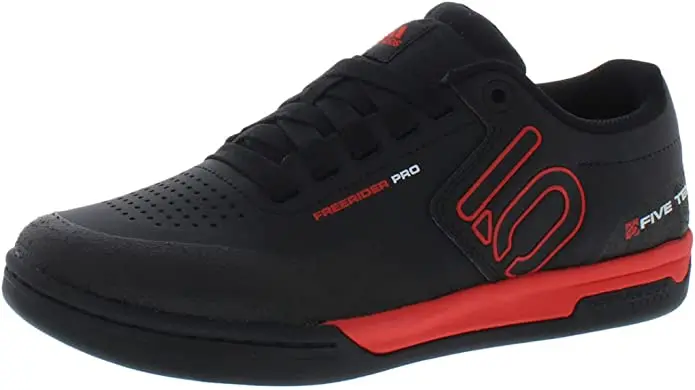
Five Ten Freerider Pro Mountain Bike Shoes
I wore these shoes during the Salty Lizard 100 gravel race. These are also my standard mountain biking shoes. They are lightweight and very comfortable. The rubber soles provide incredible grip when paired with a good mountain bike flat pedal.
- Flat pedal mountain bike shoes with an impact-resistant toe box
- Pedal-gripping rubber: Stealth S1 Dotty rubber outsole is size-specific for maximum grip on and off the pedal.
- Impact-resistant toe box: Urethane-reinforced toe box adds impact resistance.
- Quick-drying upper: Synthetic upper offers quick-drying convenience.
If you ride clipless pedals then this may be a different story. Clipless pedal-compatible shoes are designed for maximum power transfer to your pedals. This can result in an overly stiff shoe that may or may not support the foot and ankle articulation necessary for normal walking. Also, the metal cleats attached to the shoes can interfere with normal walking as well as collect mud and debris which can make it difficult to reconnect to the pedals.
If you decide to wear clipless pedal-compatible shoes then I would recommend steering clear of road cycling shoe systems. Instead, I would recommend using a set of mountain bike or gravel-specific shoes and pedals. These clipless systems are better suited for the demands and environmental conditions of a gravel race. Whatever you decide to do, be sure that you can comfortably dismount and walk your bike on various types of terrain.
Minimize/eliminate your backpack
Wearing a backpack or hip pack while riding seems commonplace anymore. I myself where an Osprey Savu hip pack on basically all of my rides. I find this style of pack to be very comfortable yet large enough to safely carry my phone and some basic supplies that I may need while out on the trail. However, on some of my longer training rides (4-5 hours long), I have found that even this small hip pack starts to cause discomfort in my lower back and hips.
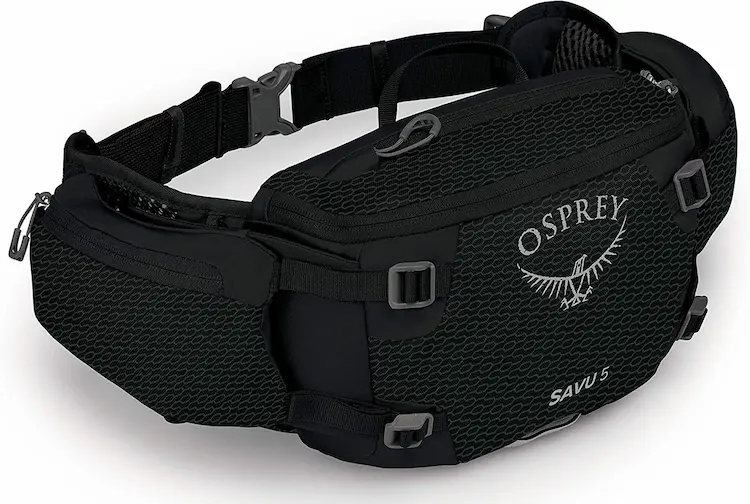
Osprey Savu 5 Lumbar Bike Hydration Pack
This is my go-to hip pack for mountain biking and training rides. I did not wear this hip pack during the Salty Lizard 100 gravel race due to the issues discussed in this post.
- Plenty of room for carrying essential supplies.
- Expandable pockets can carry up to two water bottles.
- Phone-specific pocket provides protection for your valuables.
- Easy to access zippered side pockets.
I knew that during an 8+ hour, 100+ mile gravel race the discomfort that I have felt during training would be amplified. I also knew that the hip pack would interfere with the rear-facing pockets on my cycling jersey. So, I chose to not wear my hip pack or any other backpack during the race. This choice forced me to figure out storage solutions that I could mount to my bike instead of my back. By the end of the race, I was extremely pleased with my decision to avoid wearing a pack.
If you decide to wear a backpack then I highly recommend checking out a USWE MTB Hydro, USWE Outlander Pro, or the ever-popular Camelbak Chase bike vest. Each of these backpacks is designed with bike racing in mind. They have excellent fitment to prevent the backpack from bouncing around on a rough course. They also sit high on your back allowing for easy access to rear-facing cycling jersey pockets.
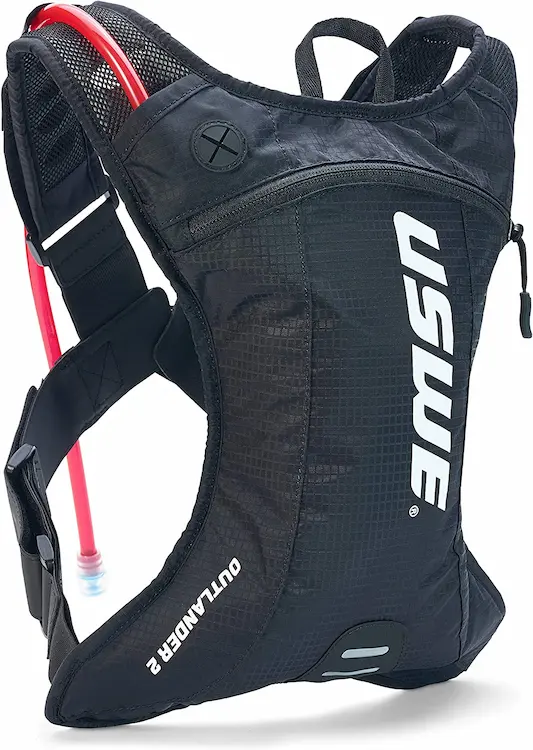
USWE Outlander Hydration Backpack
- PATENTED TECHNOLOGY: USWE uses The NDM Race Harness System - a bounce-free Harness System, with integrated elastic straps that expand along with the chest during physical exertion. This allows for a constant tight and compliant fit, enabling you to go for the epic bike ride - feeling hydrated and free to move
- STORAGE & HYDRATION: Water-resistant phone pocket to hold snacks and any electronics. Each pack includes a water bladder - select the size to find out the storage volume.
Consider bringing extra layers
I won't spend too much time on this subject but you should really consider bringing some extra layers to the race. I have said it before and I will say it again; gravel races can be very long events. They often start early in the morning when it is still cold and span through the heat of the day then sometimes back into the cold of night. The temperature shifts throughout the race can wreak havoc on your body if you are not adequately prepared.
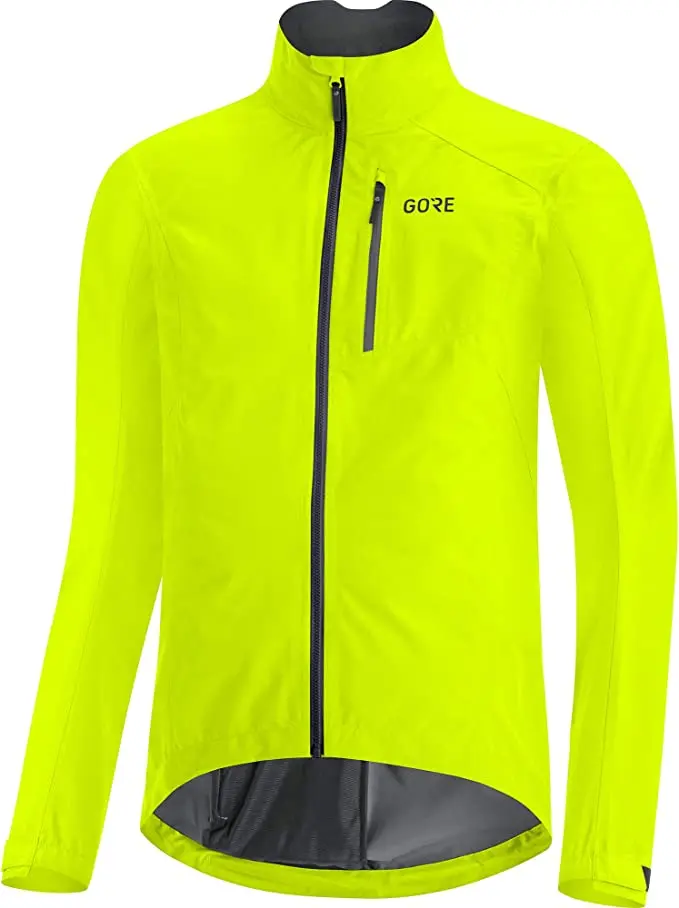
GORE WEAR Men's Cycling Jacket, Gore-TEX Paclite
- Extremely lightweight men's jacket, Ideal for wet weather conditions
- Active Fit for comfortable freedom of movement, Cycling-specific cut
- GORE-TEX PACLITE+ Technology: Waterproof, windproof, extremely breathable, compact packing size
I recommend staying up to date on the weather forecasts for the area. This can help you decide if you need to bring additional warm layers such as arm/leg warmers, a windproof vest, or perhaps a packable cycling jacket. Also, if there is even the slightest hint of rain in the forecast then I would recommend bringing a lightweight, packable rain jacket. Getting soaking wet during an unexpected rain shower is never fun. Cold rainwater can drain your energy levels faster than you would imagine. In more severe cases, this can lead to shivering which burns precious calories and impairs muscle control.
Test your riding kit before the race
As I have said before, you should always test, and be comfortable with, all equipment that you plan to use during a race. This holds true for your riding kit as well. Be sure to spend plenty of time during your training sessions wearing the exact riding gear that you plan to wear during the race. This will help you to identify any discomfort or other issues with your clothing choices. Also, be a little overly aware of any issues that you may notice during those training rides. Even small annoyances can turn into major issues when you stack on 8+ hours of riding.
Key kit issues to watch out for
- Chafing from your jersey material and/or zipper.
- Difficulty accessing items from the jersey pockets.
- Items falling out of your jersey pockets while riding.
- Difficulty pulling the jersey zipper up or down.
- Chafing from your cycling shorts.
- Cycling shorts riding up and not staying in place.
- Discomfort with the chamois material and/or fitment.
- Shoes rubbing on your heels and/or toes.
- Hot spots on the bottom of your feet while pedaling and/or standing on the pedals.
Get out there and go for it!
Alright, that wraps up yet another post in this series. I hope that you are enjoying reading this series and possibly learning a few things along the way.
Do you have any additional tips that I didn't cover in this post? Do you agree or disagree with my thoughts on this subject? I would really appreciate it if you would take the time to let us know your thoughts in the comments section below. 👇 💬


